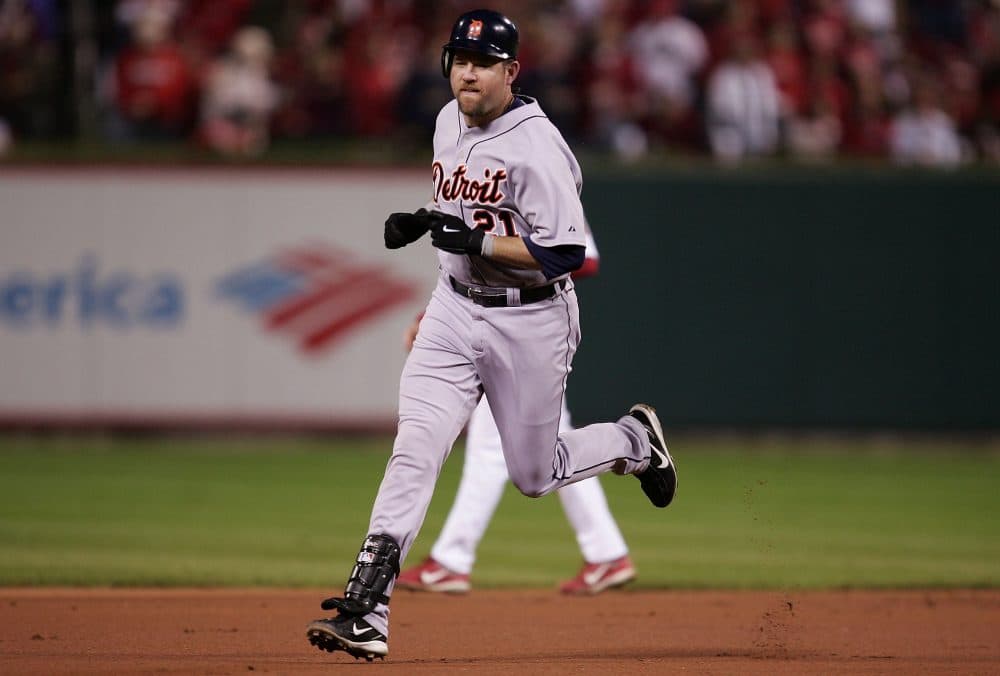Advertisement
Sean Casey: Life On The MLB Trading Block
Resume
If you’re a Major League ballplayer, you live with the possibility that you’ll be traded. For lots of players, that possibility becomes much more likely as the mid-summer trade deadline approaches.
"You start to read about possible trade rumors, and then when you see your name pop up, that’s when you start to really think about it and talk to your wife about it," former slugger and first baseman Sean Casey said. "'What if we got traded here? What if we got traded there?'”
Toward the end of his 12-year Major League career, Casey got traded a lot. He recalls one transaction with great glee. It happened 10 years ago, right at the Major League trade deadline, which, by the way, is coming up this Monday. Casey was employed by the Pittsburgh Pirates, and the team had just demonstrated their appreciation by staging Sean Casey Bobblehead Night.
"There was a sold out crowd, and I didn’t play that night, because they knew I was going to get traded, and they didn’t want me to get hurt," Casey said. "You know, I live in Pittsburgh now. I still have people that say, 'Man, I can’t believe I was at your bobblehead night. You didn’t even play!' I got traded the next day. Hah!"
Casey welcomed the trade, which sent him to the Detroit Tigers, where he’d be playing for the very successful Jim Leyland, known as a players’ manager. But like almost all trades, this one came with some complications more significant than a bobblehead night minus the star attraction.
"We had just bought a house that day, it just turns out, the day we were leaving we were closing on a house, and Jim Leyland calls me," Casey said. "It sounds like he had just smoked a couple of cigarettes. He’s like, 'Heya, Case, I just want to tell ya, so excited to have you.' And he’s like, 'Can you meet us in Tampa for the game tonight?' And I’m like, 'Oh, 100 percent, Skip. I’ll meet you in Tampa tonight. I’ll be there for the game.' So I went and told my wife, I was like, “Listen, good luck closing on the house.” Luckily, we got through that together. We still live in that house, too. Ten years later. We still live in the house she closed on."
When he reached Tampa, Casey was delighted to learn that Leyland remembered that the guy he’d just acquired lacked at least one of the tools necessary to a great player.
"You know, I was never known for my speed," Casey said. "And Leyland comes over and grabs me when I’m at the lockers. 'Hey, I need to talk to you.' I mean, it’s like, 'All right, kid. We’re gonna give you the signs.' So he’s like, 'You get on first base with a single or a walk, look into the dugout to me.' He goes, 'When we catch eyes, stay with me. If I jump up and never come back down, you steal.'"
Playing for Jim Leyland wasn’t the only benefit in being traded to the Tigers. Whereas the Pirates were an also-ran, the Tigers were in first place. Casey was thrilled with the opportunity to join a contender.
"Oh, my gosh! Are you kidding me? I went from the outhouse to the penthouse in, you know, one phone call. Here I am, the next thing I know, I’m in the middle of a pennant race. We beat the Yankees in that first round. We swept Oakland in the second round. Get into the World Series. You know, the dream is to get to the big leagues. Well, the dream within the dream is to hit a home run in the World Series, and, you know, rounding first base, feeling like the little kid in the backyard playing Wiffle ball, you know, giving the old: 'And Sean Casey homers in the World Series' when you’re 12. I hit two home runs in that World Series. It was like a dream come true."
That World Series ended when the St. Louis Cardinals beat the Tigers, four games to one. Nobody could blame Sean Casey for that result. He went 9-for-17 in the five games and led Detroit with five runs batted in.
A couple of years later, after stints with a total of five teams, Casey retired. In terms of geography alone, it had been a long and winding road.
"I’d stay in Jupiter, Florida, in the off-season, go to spring training and it usually was in Sarasota with the Reds, or wherever I was, in Lakeland, or Bradenton, or Fort Myers with the Red Sox for seven weeks, and then you’d go get a house in Detroit, or Pittsburgh, Cincinnati, and then you’d just continue to do that for twelve years," Casey said. "It was crazy."
For Sean Casey, that particular craziness ended after the 2008 season. For a lot of players, the last year in the big leagues marks the beginning of a difficult transition. It doesn’t sound as if Sean Casey had that problem.
"You know, I’ve got four kids at home, and I have this great job up at MLB Network that I love," Casey said. "I hadn’t taken a summer vacation since I was, like, 18, ‘til I was 34, when I retired. We’re getting ready to go to the Jersey shore for a couple weeks, so it’s always nice to kinda live a normal life, where you can enjoy the summers with your family."
And enjoy baseball – even at this time of year – because you don’t have to worry about getting a phone call from your boss telling you that you’ve been traded to Milwaukee… or Seattle… or New York… or Miami… or...
This segment aired on July 30, 2016.
